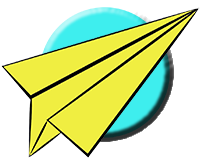Easy Clipper Paper Airplane Instructions
Easy Clipper Paper Airplane Instructions
Instructions
1. Remember the strip of paper you cut off the bottom of a letter size sheet in order to make it square? That's what you need for this plane. That's a strip with a ratio of about 1:4. This is an experimental craft so plan on making many of these zippy little flyers.
2. Fold the plane in half so the upper right point hits the lower left point.
3. Flip the paper over.
4. Fold the top edge down so the top center point hits the center line crease. Make the crease about one finger width down from the top edge. This measurement determines the overall wing area so plan on some tiral and error.
5. Fold the upper right point over so it hits the center line crease. When folded correctly, the right half of the top edge should line up with the center line crease.
6. Fold the left point over so it hits the center line crease. When folded correctly, the left half od the top edge should line up with the center line crease.
7. Flip the paper over keeping the nose at the top.
8. Fold the plane exactly in half about the existing center line crease. Be sure to line up the wing flaps for good balance.
9. Rotate the plane around so the wing flaps are up and the nose points to the left.
10. Make a crease for the first wing flap. The new crease should be parallel to the bottom edge of the fuselage and should be about one finger width up from the bottom edge. The wing are can be adjusted here by making this crease higher or lower.
11. Flip the plane over and rotate it around so the first wing flap is underneath and the nose points to the right.
12. Flip the plane over and rotate it around so the first wing flap is underneath and the nose points to the right.
13. Open up the wing flaps and adjust the wing angles so they ar even. Set the dihedral angle slightly up and put an upcurl on the wings overall.
THE THROW Launch with a flick of the wrist at any angle. After swooping and diving, it should glide out straight if it's trimmed well. If it flutters to the ground, the wing area is too lard for the weight of the paper. If it dive bombs directly for the floor, the wings are too small and the nose is too heavy for the weight of the paper.
